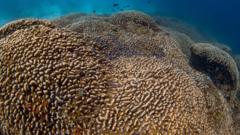*The recent discovery of an enormous coral in the southwest Pacific highlights both the beauty of natural ecosystems and the urgent need for climate action.*
**Massive Coral Discovery Offers Hope Amidst Climate Challenges**

**Massive Coral Discovery Offers Hope Amidst Climate Challenges**
*Researchers uncover the world's largest coral in the Pacific, sparking hope for marine conservation efforts.*
In a remarkable find, scientists researching the impacts of climate change in the southwest Pacific Ocean have stumbled upon the largest coral ever recorded—an immense organism that challenges perceptions of coral habitats. This mega coral, a colossal collection of interconnected tiny organisms, is estimated to be over 300 years old and outmeasures a blue whale.
The discovery was made by Manu San Felix, a videographer aboard a National Geographic ship exploring the remote areas of the Pacific. What began as a dive intended to observe a sunken ship turned into an awe-inspiring encounter with the coral, located in the Solomon Islands. "Diving down to see the coral felt like entering a cathedral underwater," San Felix expressed emotionally. He mused about the coral's ancient presence, stating, "It was here when Napoleon was alive."
Measuring an impressive 34 meters in width, 32 meters in length, and standing at 5.5 meters high, this coral thrives in deeper waters, possibly secluding it from the detrimental effects of warming surface temperatures. Scientists, utilising underwater measuring tools, confirmed its health during the expedition. The event coincided with the UN climate talks, COP29, taking place in Baku, Azerbaijan, which aims to initiate action against climate change.
Trevor Manemahaga, the climate minister for the Solomon Islands, emphasized the significance of this newly discovered coral, declaring, "This is a special place and it needs to be protected. Coral is very, very important for our economic survival." He warned that small island nations, like his, are particularly vulnerable to climate impacts, experiencing intensified cyclones and coastal erosion.
The negotiation efforts at COP29 are critical, especially with many developing nations seeking increased financial support from wealthier countries for climate change adaptation strategies. Manemahaga highlighted that with more funding, the Solomon Islands could diversify its economy, reducing dependence on damaging practices like logging, which contributes to pollution harming coral ecosystems.
Scientists with the National Geographic expedition expressed optimism regarding the coral's health amidst surrounding ecological stress. Eric Brown, a coral researcher, described the large and thriving coral as “a beacon of hope.” This specimen, identified as Pavona clavus, serves as a habitat for various marine life, including shrimp and fish, and offers insights into historical oceanic conditions.
However, a recent report flags a critical alarm: 44% of corals in warm waters face the threat of extinction—an alarming increase since 2008, as noted by the International Union for the Conservation of Nature. The urgency of preserving marine environments becomes increasingly clear as climate change continues to challenge ecosystems globally.
The discovery was made by Manu San Felix, a videographer aboard a National Geographic ship exploring the remote areas of the Pacific. What began as a dive intended to observe a sunken ship turned into an awe-inspiring encounter with the coral, located in the Solomon Islands. "Diving down to see the coral felt like entering a cathedral underwater," San Felix expressed emotionally. He mused about the coral's ancient presence, stating, "It was here when Napoleon was alive."
Measuring an impressive 34 meters in width, 32 meters in length, and standing at 5.5 meters high, this coral thrives in deeper waters, possibly secluding it from the detrimental effects of warming surface temperatures. Scientists, utilising underwater measuring tools, confirmed its health during the expedition. The event coincided with the UN climate talks, COP29, taking place in Baku, Azerbaijan, which aims to initiate action against climate change.
Trevor Manemahaga, the climate minister for the Solomon Islands, emphasized the significance of this newly discovered coral, declaring, "This is a special place and it needs to be protected. Coral is very, very important for our economic survival." He warned that small island nations, like his, are particularly vulnerable to climate impacts, experiencing intensified cyclones and coastal erosion.
The negotiation efforts at COP29 are critical, especially with many developing nations seeking increased financial support from wealthier countries for climate change adaptation strategies. Manemahaga highlighted that with more funding, the Solomon Islands could diversify its economy, reducing dependence on damaging practices like logging, which contributes to pollution harming coral ecosystems.
Scientists with the National Geographic expedition expressed optimism regarding the coral's health amidst surrounding ecological stress. Eric Brown, a coral researcher, described the large and thriving coral as “a beacon of hope.” This specimen, identified as Pavona clavus, serves as a habitat for various marine life, including shrimp and fish, and offers insights into historical oceanic conditions.
However, a recent report flags a critical alarm: 44% of corals in warm waters face the threat of extinction—an alarming increase since 2008, as noted by the International Union for the Conservation of Nature. The urgency of preserving marine environments becomes increasingly clear as climate change continues to challenge ecosystems globally.





















